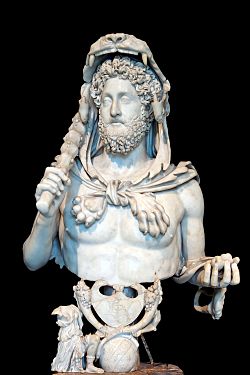The Temple of Jupiter Optimus Maximus, also known as the Temple of Jupiter Capitolinus (Latin: Aedes Iovis Optimi Maximi Capitolini; Italian: Tempio di Giove Ottimo Massimo; lit. 'Temple of Jupiter, the Best and Greatest') was the most important temple in Ancient Rome, located on the Capitoline Hill. It was surrounded by the Area Capitolina, a precinct where numerous shrines, altars, statues and victory trophies were displayed.
The first building was the oldest large temple in Rome, and, like many temples in central Italy, shared features with Etruscan architecture. It was traditionally dedicated in 509 BC, and in 83 BC was destroyed by fire, and a replacement in Greek style completed in 69 BC (there were to be two more fires and new buildings). For the first temple sources report Etruscan specialists being brought in for various aspects of the building, including making and painting the extensive terracotta elements of the Temple of Zeus or upper parts, such as antefixes. But for the second building they were summoned from Greece, and the building was presumably essentially Greek in style, though like other Roman temples it retained many elements of Etruscan form. The two further buildings were evidently of contemporary Roman style, although of exceptional size.
The first version is the largest Etruscan-style temple recorded, and much larger than other Roman temples for centuries after. However, its size remains heavily disputed by specialists; based on an ancient visitor it has been claimed to have been almost 60 m × 60 m (200 ft × 200 ft), not far short of the largest Greek temples. Whatever its size, its influence on other early Roman temples was significant and long-lasting. Reconstructions usually show very wide eaves, and a wide colonnade stretching down the sides, though not round the back wall as it would have done in a typical Greek temple. A crude image on a coin of 78 BC shows only four columns, and a very busy roofline.With two further fires, the third temple only lasted five years, to 80 AD, but the fourth survived until the fall of the empire. Remains of the last temple survived to be pillaged for spolia in the Middle Ages and Renaissance, but now only elements of the foundations and podium or base survive; as the subsequent temples apparently reused these, they may partly date to the first building. Much about the various buildings remains uncertain.










